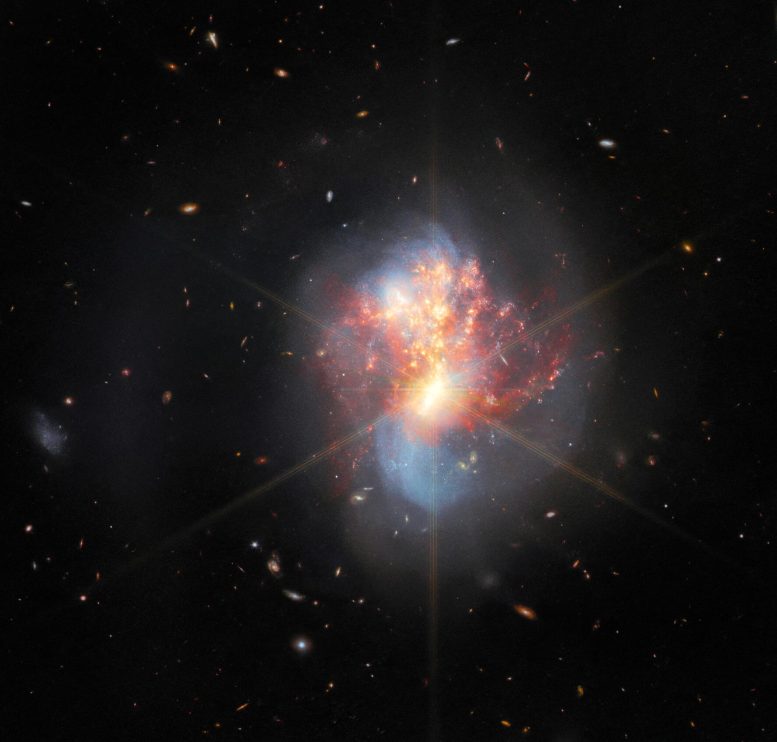
The two galaxies swirl into a single chaotic object in the center. Long, blue spiral arms stretch vertically, faint at the edges. Hot gas spreads horizontally over that, mainly bright red with many small gold spots of star formation. The core of the merging galaxies is very bright and radiates eight large, golden diffraction spikes. The background is black, with many tiny galaxies in orange and blue. Credit: ESA/Webb, NASA & CSA, L. Armus & A. Evans
This image from the James Webb Space Telescope showcases an entwined pair of interacting galaxies known as IC 1623. It lies approximately 270 million light-years from Earth in the constellation Cetus. The two galaxies in IC 1623 are plunging headlong into one another in a process known as a galaxy merger. A frenzied spate of star formation was ignited by their collision. This is known as a starburst and is creating new stars at a rate more than twenty times that of the Milky Way galaxy.

Here, the Webb Picture of the Month of merging galaxies IC 1623 A and B is juxtaposed with a new image from the NASA/ESA Hubble Space Telescope. In the Webb MIRI image, the bright core, heated gas and dust, and young star-forming regions are all visible. The Hubble and Webb NIRCAM images show the galaxies distorted spiral arms, while MIRI reveals the faint ghostly glow of interstellar dust. Credit: ESA/Webb, NASA & CSA, L. Armus & A. Evans, Acknowledgement: R. Colombari
This interacting galaxy system is particularly bright at infrared wavelengths, making it an ideal proving ground for NASA/ESA/CSA Webb’s ability to study luminous galaxies. A team of astronomers captured IC 1623 across the infrared portions of the electromagnetic spectrum using a trio of Webb’s cutting-edge scientific instruments: MIRI, NIRSpec, and NIRCam. In so doing, they provided an abundance of data that will allow the astronomical community at large to fully explore how Webb’s unprecedented capabilities will help to unravel the complex interactions in galactic ecosystems. These observations are also accompanied by data from other observatories, including the NASA/ESA Hubble Space Telescope, and will help set the stage for future observations of galactic systems with Webb.
The merger of these two galaxies has long been of interest to astronomers,. In fact, it has previously been imaged by Hubble and by other space telescopes. The ongoing, extreme starburst causes intense infrared emission, and the merging galaxies may well be in the process of forming a supermassive black hole. A thick band of dust has blocked these valuable insights from the view of telescopes like Hubble. However, Webb’s infrared sensitivity and its impressive resolution at those wavelengths allows it to see past the dust and has resulted in the spectacular image at the top of this article, which is a combination of MIRI and NIRCam imagery.
The luminous core of the galaxy merger turns out to be both very bright and highly compact, so much so that Webb’s diffraction spikes appear atop the galaxy in this image. The 8-pronged, snowflake-like diffraction spikes are created by the interaction of starlight with the physical structure of the telescope. The spiky quality of Webb’s observations is particularly noticeable in images containing bright stars, such as Webb’s first deep field image.
Reference: “GOALS-JWST: Hidden Star Formation and Extended PAH Emission in the Luminous Infrared Galaxy VV 114” by Aaron S. Evans, David Frayer, Vassilis Charmandaris, Lee Armus, Hanae Inami, Jason Surace, Sean Linden, Baruch Soifer, Tanio Diaz-Santos, Kirsten Larson, Jeffrey Rich, Yiqing Song, Loreto Barcos-Munoz, Joseph Mazzarella, George Privon, Vivian U, Anne Medling, Torsten Boeker, Susanne Aalto, Kazushi Iwasawa, Justin Howell, Paul van der Werf, Philip N. Appleton, Thomas Bohn, Michael Brown, Christopher Hayward, Shunshi Hoshioka, Francisca Kemper, Thomas Lai, David Law, Matthew Malkan, Jason Marshall, Eric Murphy, David Sanders and Sabrina Stierwalt, Submitted, Astrophysical Journal Letters.
arXiv:2208.14507
MIRI was contributed by ESA and NASA, with the instrument designed and built by a consortium of nationally funded European Institutes (The MIRI European Consortium) in partnership with JPL and the University of Arizona.
NIRSpec was built for the European Space Agency (ESA) by a consortium of European companies led by Airbus Defence and Space (ADS) with NASA’s Goddard Space Flight Center providing its detector and micro-shutter subsystems.
Results based on this observation of IC 1623 have been published in the Astrophysical Journal.


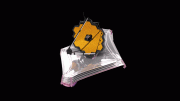
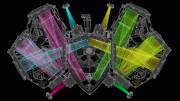
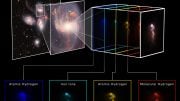
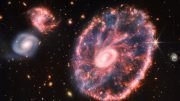
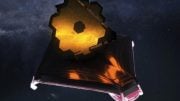
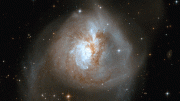

I am not a physicist, or how ever it’s spelled, but just a curious observer. But why do I only mostly see articles of JWST images of galaxies and things we already have seen. Where is the exoplanet discoveries that are truly trying to discover outside life. Only looking at dwarf red stars and Jupiter is not the only places to point this billions of dollars telescope. How about exoplanets that actually are in a system of a yellow sun. It seems like scientists are scared to show those images and discoveries. Oh this red dwarf star or oh this chaotic galaxy that could never be habitat suitable. Look at something that is close to being like our solar system. Wasting time seeing if there is a partical that won’t even prove anything but to show the worth of bs pay. Show effort that is gearing towards a sun system similar to ours, please. If I’m totally wrong then cool, but if you are honestly looking for life then where do you have proof of the images of effort